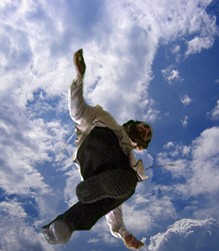Transit / Fresh Paint 2 / Project
A Ford Transit is placed upside-down like a bulky, unattractive animal cast on its back. This sight forthwith conjures up a memory etched in other car images associated with catastrophes, such as the image of the overturned car in Andy Warhol’s Five Deaths on Orange (1963) or the vision of the crash residue revealed during a journey in the desert in David Lynch’s Wild at Heart (1990), or the leit motif of crashed cars in David Cronenberg’s Crash (1992), or the figure of a survivor,possibly a ghost, who escaped a car crash, emerging as a prologue in another film by Lynch, Mulholland Drive (2001). The image of the car is what remains: it is both the testimony and the body that lives on after a lethal accident in which another life has been cut short. In many of the aforementioned cinematic narratives the nightmarish sight of the car accident is congruent with a prolonged journey engulfed by a sense of floating andanear-surrealistic,illusoryair.Porat Salomon’s Transit, his awkward voyage truck-track likewise belongs to a chronicle of journey imagery addressed in his works, manifested in images of transition moments and of sites and means associated with journeys and travel (such as the caravans).
Black machine oil, resembling the sediment left after a fire,was poured on the bottom of the work Transit, or, in fact, on what used to be the car’s ceiling. This turbid liquid only reinforces the sense of catastrophe that befell Salomon’s truck-track. There is no body in the car, but a dancing video figure of a Breslau Hasid is projected on the black oil puddle.This ghostly video image appears trapped between heaven and earth, or resembles a celestial entity conjured up by means of the black fluid,“like an angel in a baroque ceiling painting reflected in the floor,”as Salomon himself described it. Was it a dark occurrence, a forbidden invocation of celestial entities that has caused this figure to be mirrored on the surface of the ground in the lower section of the work? Was it a disaster or rather a blessed magical moment of world reversal which made possible the revelation of a kingdom of Heaven in the ecstatic dance of the Transit Hasid? These questions are handed over to the viewer and his/her speculative faculty.
This set of questions is called to the round table of contemporary art discourse on account of Salomon’s work which raises references belonging to classical art, to its myriad images and subjects, as well as allusions to contemporary art - to cinema, to manifestations of Americana in the modernist scene. All these, however, are insufficient unless they are presented as means of transition to the after-life. Moreover, these voyage vehicles are expected to deviate from their trajectory toward another route interspersed with iconoclastic signs and the references of culture (a Jewish culture) which chances upon the wretched Transit since it does not adhere to spectacles, polished forms, or fancy attributes.
Sarit shapira

